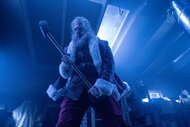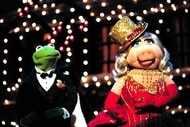‘Top Gun: Maverick’ director explains what it took to ace Tom Cruise’s awesome flight scenes
‘You just can’t fake what it’s like to be in one of these airplanes,’ says director Joseph Kosinski.

Anyone who fueled up on Top Gun: Maverick this summer knows the chart-shattering sequel to Tom Cruise’s 1986 classic features some of the most realistic and hair-raising aerial acrobatics ever committed to film. What you may not know, though, is how Cruise and director Joseph Kosinski collaborated with a team of ace real-life pilots to capture the movie’s authentic aerial combat sequences.
There’s no CGI along for the ride as Cruise and his crack team of present-day daredevils take what seems like an impossible fight to the movie’s unnamed bad guys. That’s because the onscreen action was captured exactly as it actually happened — a feat that required tons of practical expertise from the U.S. military pros who fly the film’s cutting-edge Boeing F/A-18E/F Super Hornet (as well as legacy aircraft like Cruise’s old-school Grumman F-14 Tomcat) — all as part of a day’s work.
“I saw online that some Navy pilots were putting on YouTube these videos where they would film their training exercises by putting a little GoPro on the canopy next to them,” Kosinski told The New York Times of his initial research into how Maverick would set up its in-flight action. “And so there was this kind of off-kilter angle that was capturing their training flight, and when I saw that, I was like, this is more interesting than any aerial sequence I’ve seen in a movie in a long time. So, [I wanted to] get the choreography of dog fighting, and do it in a two-seat airplane so Tom can be in the back and the [actual] Top Gun pilot can be in the front and [a real] Top Gun pilot is in the same thing that Tom’s wearing.”
Though Cruise is famous for performing his own stunts, there are some things that just have to be handled by the experts — and that includes piloting an extraordinarily expensive aircraft paid for by the U.S. Department of Defense. Kosinski said Cruise challenged all of the film’s flying cast to get themselves into “the same aviation shape that he was,” easing the illusion that the helmeted pilots actually at the helm were Cruise and the rest of the cast.
“…I can shoot Tom with these cameras, and it’ll look like Tom’s flying it,” Kosinski explained. “That was the inspiration. Then we went to Top Gun [the real-life, Nevada-based Navy Fighter Weapons School], and we worked with the best pilots in the world flying these sequences for us.”
Committing so much effort to nailing the real look and feel of a dogfighter’s view from the cockpit, confessed Kosinski, “was a lot of work.” But, he said, there’s simply no CGI substitute for capturing the real thing. “You just can’t fake what it’s like to be in one of these airplanes,” he said. “You can’t fake the imagery of what it’s like to be going 600 miles an hour 30 feet above the ground through a canyon. I think, as an audience member, something in your brain tells you it’s real, and there is a visceral response, and so I’m glad we did it.”
The blockbuster sequel continues to swoop box office receipts, collecting a global $1.4 billion and $731 million domestic haul as the year’s highest-flying movie (as well as Cruise’ highest-grossing film ever). If you missed the movie’s initial flight in theaters, not to worry: Top Gun: Maverick has just come in for landing at on-demand streaming platforms, including Amazon Prime and Apple TV+.
Looking for some action and adventure? Peacock has a slew of titles to get your heart rate up, including The Fast and the Furious, Ambulance, and Flashpoint.


























